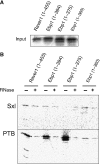Structural insights into the transcriptional and translational roles of Ebp1
- PMID: 17690690
- PMCID: PMC1994118
- DOI: 10.1038/sj.emboj.7601817
Structural insights into the transcriptional and translational roles of Ebp1
Abstract
The ErbB3-binding protein 1 (Ebp1) is an important regulator of transcription, affecting eukaryotic cell growth, proliferation, differentiation and survival. Ebp1 can also affect translation and cooperates with the polypyrimidine tract-binding protein (PTB) to stimulate the activity of the internal ribosome entry site (IRES) of foot-and-mouth disease virus (FMDV). We report here the crystal structure of murine Ebp1 (p48 isoform), providing the first glimpse of the architecture of this versatile regulator. The structure reveals a core domain that is homologous to methionine aminopeptidases, coupled to a C-terminal extension that contains important motifs for binding proteins and RNA. It sheds new light on the conformational differences between the p42 and p48 isoforms of Ebp1, the disposition of the key protein-interacting motif ((354)LKALL(358)) and the RNA-binding activity of Ebp1. We show that the primary RNA-binding site is formed by a Lys-rich motif in the C terminus and mediates the interaction with the FMDV IRES. We also demonstrate a specific functional requirement for Ebp1 in FMDV IRES-directed translation that is independent of a direct interaction with PTB.
Figures





References
-
- Brunger AT, Adams PD, Clore GM, DeLano WL, Gros P, Grosse-Kunstleve RW, Jiang JS, Kuszewski J, Nilges M, Pannu NS, Read RJ, Rice LM, Simonson T, Warren GL (1998) Crystallography and NMR system: a new software suite for macromolecular structure determination. Acta Crystallogr D 54: 905–921 - PubMed
-
- Collaborative Computer Project No. 4 (1994) The CCP4 suite: programs for protein crystallography. Acta Crystallogr D 50: 760–763 - PubMed
Publication types
MeSH terms
Substances
Grants and funding
LinkOut - more resources
Full Text Sources
Molecular Biology Databases
Research Materials

